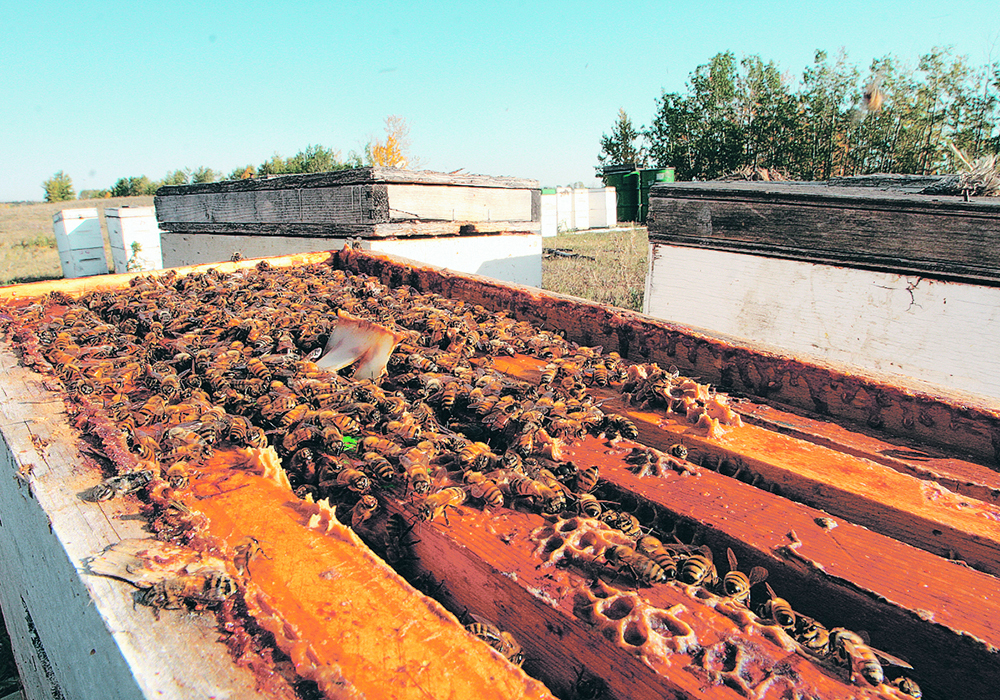Unseasonably warm temperatures that lasted for much of this fall had a honey industry leader cautiously optimistic about the readiness of Alberta’s bee colonies for the coming winter.
“Most people that I’m talking to are saying that their bees look excellent going into the winter — like really, really excellent, better than they’ve been for quite a few years,” said Lorne Prins, vice-president of the Alberta Beekeepers Commission.
However, overall honey yields in Canada likely declined this year by about 10 to 20 percent, said Rod Scarlett, executive director of the Canadian Honey Council. Beekeepers who were still recovering from average losses of about half their colonies due to high levels of varroa mites last winter faced varying conditions this summer, he said.
Read Also

Why feds imposed EV tariffs
Moe and Kinew have a fight on their hands when it comes to eliminating the EV tariff. Canada has to worry about pissing off the U.S. and Mexico and hundreds of thousands of auto workers.
“From what I’ve heard this year, a lot of beekeepers would have a very successful yard and then right next to it would have a yard that’s well below average, so it doesn’t seem like there was rhyme or reason for this to occur,” said Scarlett.
However, numerous factors could have been at play, including a timely rain in one area that missed a neighbouring one, he added.
“We had an incredible rain in June,” said Prins, about how weather conditions affected his own operation, which is the Gull Lake Honey Co. near Lacombe, Alta. “And we even had a fairly wet early July, I believe, and then things just really dried out.”
Scarlett said honey production was also weakened because many beekeepers were forced to split their colonies early in the season to make up for varroa losses.
Thirty-one new records for high temperatures were set Sept. 28 in communities across Alberta. They ranged from 29 C in Lacombe and 31.9 C in Claresholm to 33.8 C in Medicine Hat.
Prins said Oct. 5 that warm weather in Alberta had resulted in favourable conditions for bees as honey producers start to get colonies ready for winter.
“At this time last year, I was predicting very high winter losses … and this can always change, but my prediction as of today is to have below average winter losses this winter unless we get a real doozy of a winter.”
Beekeepers faced heat waves, wildfire smoke and drought in the summer of 2021 that affected honey production. The warm conditions also favoured the growth of varroa mites, with some producers facing losses of as much as 90 percent of their colonies.
However, the mites were also killed when the colonies died, said Scarlett.
“So, we’re basically starting off with 50 percent strong colonies with fewer varroa.”
He said higher temperatures across the Prairies as of Oct. 5 meant bees were still making brood, referring to the eggs, larvae and pupae of the insects. However, he warned such conditions also favour varroa mites, which means beekeepers need to check their colonies and stay on top of anti-varroa treatments.
It also meant bees were continuing to fly at a time when they typically would be staying within their hives and keeping warm, he added.
“It’s like every day they can go out, and there’s not a lot of nutrition (in flowers) out there for the bees because everything’s done for the fall.”
As a result, beekeepers could face increased costs for feeding the insects with sugar at a time of soaring prices for the carbohydrate, he said. Producers were already dealing with rising inputs such as the high cost of fuel, said Prins.
“Everything we touch has gotten more expensive, like the cost of our standard beekeeping equipment… our woodenware or our hive equipment, just the boxes themselves have doubled in price in the last year and a half.”
Scarlett said a fortunate thing about the current situation is the “price of honey has remained very strong. And so compared to four years ago, it’s almost double what it was, so despite the fact that honey crops may be down, the income levels may be close to normal.”
Prins had hoped to expand the Gull Lake Honey Co. next year but he’s rethinking that plan.
“When I see the cost of just raw materials, it’s a really tough pill to swallow… can we count on continued high prices of honey? I don’t know. I think honey stays high for a while, but it’s just so hard to know.”
















